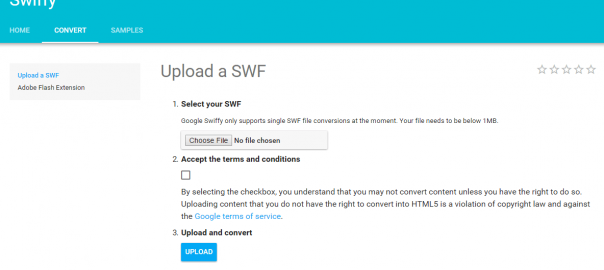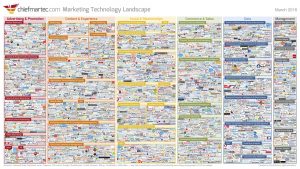Geological scientists like Mr. Dwayne “The Rock” Johnson have a big prediction for California. It’s the home of Silicon Valley and it’s sitting smack dab on top of the San Andreas faultline – just one big slip away from a major earthquake. And now you must want to know:
What does that possibly have to do with Flash and HTML5 ads?

Let the pondering commence. Think about it. In the case of the San Andreas fault, predictions about impending earthquakes are just strong beliefs in a catastrophe waiting to happen. The data seems to say it’s very likely. But the data just doesn’t say when.
Within our analogy, let’s think about Adobe Flash. With Flash, the big catastrophic slip already happened in 2015. It’s no longer just a prediction. The rich media ad world has been shaken up.
That means it’s high time to start figuring out what to do with all that remaining Flash ad inventory. iOS (phone and tablets), Google browsers (laptops on battery power), Amazon, and Facebook are among the power players throwing Flash a retirement party. Both advertisers and publishers alike have to make strategic adjustments.
Who Killed Flash?

The short answer is everybody. But during the last part of 2015, Flash ended up taking a beating that made it look like it tried to french kiss Bruce Lee’s nunchuks.
- Mr. Steve Jobs wrote an open letter. He wasn’t a fan. Flash suffered on the iOS platform. It was a no-go. (2010)
- Mozilla disabled it for 24 hours over various concerns. But sent a big wave of Flash’s increasing unpopularity. (2015)
- Google announces that Chrome will auto-pause Flash on laptops – as a move to conserve battery performance (2015)
- Facebook indicates they will drop support (2015)
- Amazon drops Flash ad support (2015)
If you’re still on the fence about whether or not Flash is dead, we’ll let you get back to napping or such things as denying climate change. No need to read further. Insert Kung Fu roundhouse here.
Quantifying the Flash Ad Catastrophe
In terms of the “first world problems” generation, rich media ads with Flash have been around forever. In 2015, there were likely more than 5 Billion ad impressions that were blocked because the ads were created in Flash. And that was just mobile rich media ads alone.
As more and more of the major players drop support for Flash, running Flash ads becomes increasingly ineffective and wasteful. And the value of all those ad inventory creatives are bottoming out. Not unlike the price of crude oil and the Canadian Prime Minister Justin Trudeau’s piggy bank filled with “loonies” (i.e. Canadian dollars).
When the Google Chrome team started auto-pausing Flash ads in 3rd and 4th quarters of 2015, they doubled the default rate of Flash ads. Flash ads are now next to useless for over 15% of their overall impressions. But mobile platforms are like a full extinction event for Flash. Over 98% of Flash ads will be rendered useless on smartphones.
Much Ado About Flash Ad Inventory

In the ecommerce world, imagine that you buy a huge amount of something you can’t sell. Maybe you bought a 1,000 units of David Hasselhoff t shirts wholesale.
You can’t put them into your premium retail shelf space and expect them to sell. If you want to move them, you’ll need to be creative. Either sell them at a discount, find a way to turn them into folk art on Etsy, or put them in storage until Mr. Hasselhoff makes a come back and wins an Academy Award. Then you’ll have a collectors item on your hands.
Flash ads are rapidly becoming the equivalent of those 1,000 Knight Rider t shirts. So let’s consider what advertisers can do with them. And perhaps a little brainstorming on how it might be an opportunity for publishers too.
What Can Advertisers Do With All That Flash?
It might be all HTML5 bling now, but make it in the day it was Flash. And you know I’m up on my history – as demonstrated by my previous meme choices.
As an advertiser, if you have a bunch of flash based ads, you have two primary choices, and one less desirable third option:
- Utilize those ads on an ad network with Flash to HTML5 conversion tools,
- Do the conversion yourself using tools like Swiffy. It’s a Google Developer tool that lets you convert Flash to HTML5.
- Find publisher that are taking direct ad placements that target desktop traffic and accept Flash.

The third strategy is the least valuable. And that’s because the trend of Flash being phased out is well underway. If you try it, make sure you confirm they have scripts that detect when Flash is disabled on the visitors’ browsers. In some cases, that’ll let you fall back to a static ad image instead.
Without the conversions you have to be aware of what you’re up against. Your advertising is running up against almost full annihilation on mobile platforms. Likewise, on the desktop or laptop browsers, you’re still up against a ~15%+ default rate.
If you’re not converting them, decommission them. Then move forward by creating your new rich media ads using HTML5 technology and tools.
How Can Publishes Take Advantage of the Last Remnants of Flash Ad Inventory?

There will be hold outs. Although publishers have to make the transition as well, they might be able to exploit the big Flash to HTML5 landslide transition of 2015.
Publishers targeting desktop users might want to do a flash sale (get it?). I’ve been waiting this whole time to slip that one in there. Bad dum tss. It was a pun!
The ad networks are dropping support for Flash. But you can still arrange to sell your ad inventory for flash ad campaigns. Consider going direct to advertisers, private ad exchanges, or other networks. But forget about AdSense. Google is not going to fill your ad inventory with Flash for any price.
If you’re running ad video units, make sure that they support both HTML5 and Flash. That’ll let you make a seamless transition while picking up advertisers remaining flash ad inventory.
You Didn’t Need to See It Coming
At this point, it doesn’t matter if you saw it coming. The day of Flash are finally over. 2015 was the irrecoverable big slide. Flash ads are well beyond the point of no return.
Let us know if you were prepared. Are you already transitioning to HTML5, or still working with leftover Flash ad inventory? Please comment below to let us know.
Digital & Social Articles on Business 2 Community(41)
Report Post



